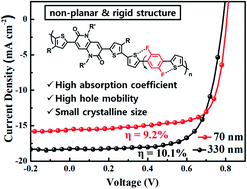Designing a naphthyridinedione-based conjugated polymer for thickness-tolerant high efficiency polymer solar cells†
Abstract
Conjugated polymers with a high absorption coefficient and high charge mobility are essential for high power conversion efficiency (PCE) and large area roll-to-roll processing of polymer solar cells. However, only a few conjugated polymers with both properties have been reported so far. Recently, we have reported an innovative naphthyridinedione (NTD)-based highly crystalline polymer (PNTDT-2F2T) with an exceptionally high absorption coefficient (α = 1.6 × 105 cm−1) and charge mobility (μh = 8.6 × 10−3 cm2 V−1 s−1), which showed 9.6% PCE with a thick active layer (210 nm). However, the PCE decreases considerably to 7.4% with a thin active layer (80 nm) due to a reduction in the photocurrent owing to the still smaller absorption coefficient and rather larger crystalline domain size of PNTDT-2F2T. To develop a thickness-tolerant high efficiency polymer solar cell aiming at low-cost commercial manufacture, we report a newly designed NTD-based conjugated polymer (PNTD4T-2FB) with an increased absorption coefficient and controlled crystallinity that contains 1,4-difluorobenzene units, in this work. The smaller crystal size (crystalline coherence length (CCL) = 2.20 nm) and higher absorption coefficient (α = 2.0 × 105 cm−1) of PNTD4T-2FB compared to those of PNTDT-2F2T (CCL = 3.19 nm) facilitate charge generation while maintaining a high carrier mobility (μh = 2.92 × 10−3 cm2 V−1 s−1). Consequently, the PNTD4T-2FB based device shows improved PCE (10.1%) with a thicker active layer (330 nm) while keeping a PCE of 9.2% for an active layer of only 70 nm thickness as well. Comparative analysis with PNTD4T-B (which does not contain fluorine) suggests that the superior characteristics of PNTD4T-2FB are attributable to the slightly twisted but rigid backbone arising from the S–F intra-molecular non-bonding interaction between 1,2-difluorobenzene and thiophene.



 Please wait while we load your content...
Please wait while we load your content...